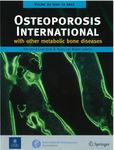Per i Soci Come consultare le riviste dall'area personale - www.siommms.it
←
→
Trascrizione del contenuto della pagina
Se il tuo browser non visualizza correttamente la pagina, ti preghiamo di leggere il contenuto della pagina quaggiù
Introduzione Il costante aggiornamento medico scientifico è fondamentale per qualun- que medico. Per renderlo più agevole la SIOMMMS ha pensato di offrire ai propri Soci la possibilità di consultare gratuitamente due testate scientifiche di rilevante importanza: “Osteoporosis International” e “Calcified Tissue International”. Questa importante possibilità è frutto di un accordo fra la SIOMMMS e la Springer, casa editrice delle due riviste. Osteoporosis International Osteoporosis International è una rivista medica peer-reviewed pubblicata da Springer Nature con la collaborazione della International Osteoporosis Foundation e della National Osteoporosis Foundation. Lanciata nel 1990, è pubblicata mensilmente e costituisce un forum per la comunicazione e lo scambio di idee sulle più recenti ricerche riguardanti la diagnosi, la preven- zione, il trattamento e la gestione dell’osteoporosi e di altre malattie meta- boliche delle ossa, nonché articoli didattici e case reports. Pubblica ricerche cliniche e documenti originali che indicano i progressi e i risultati raggiunti . I condirettori sono J.A. Kanis e F. Cosman. Il Journal of Citation Reports ha assegnato alla rivista un impact factor di 3,819 (dato 2018). Calcified Tissue International and Musculoskeletal Research Calcified Tissue International è una rivista medica peer-reviewed pubblica- ta da Springer Nature con la collaborazione dell’International Osteoporosis Foundation. Dal 1967 al 1978 la rivista è stata pubblicata con il nome Cal- cified Tissue Research. A partire dal volume 93 la rivista ha cambiato il titolo in Calcified Tissue Inter- national Musculoskeletal Research, condirettori S.H. Ralston and R. Rizzoli. Viene pubblicata mensilmente e include ricerche e recensioni originali sulla struttura e la funzione delle ossa e di altri sistemi mineralizzati negli organi- smi viventi, nonché studi clinici di rilevanza sulle malattie ossee, il metaboli- smo minerale, la funzione muscolare e le interazioni muscolo-scheletriche. I coeditori sono Roberto Civitelli e Stuart H. Ralston. Il Journal of Citation Reports ha assegnato alla rivista un impact factor di 3,265 (dato 2018).
Come fare
passo passo
1
Ú Accedere al sito www.siommms.it
Ú Cliccare su “Riviste” nella fascia blu, in alto.
2
Ú Ogni socio dovrà inserire Username e Password per accedere all’area personale.3
Ú Una volta loggati, si vedranno le copertine delle due riviste scientifiche disponibili.
Ú Cliccando sulla rivista desiderata, si entra nel sito della rivista come utente privilegiato.
4
Ú Nel sito della rivista, è visibile l’elenco degli articoli pubblicati.
Ú Cliccare sull’articolo scelto.5
Ú Si accede all’abstract e nella colonna di destra si potrà scaricare il PDF.
6
Calcified Tissue International (2019) 105:107–108
https://doi.org/10.1007/s00223-019-00553-w
LETTER TO THE EDITOR
Effect of Zoledronate on Bone Loss After Romosozumab/Denosumab:
2‑Year Follow‑up
Anne M. Horne1 · Borislav Mihov1 · Ian R. Reid1,2
Received: 25 March 2019 / Accepted: 11 April 2019 / Published online: 17 April 2019
© Springer Science+Business Media, LLC, part of Springer Nature 2019
Romosozumab and denosumab are monoclonal antibodies Figure 1 shows the evolution of BMD over the 2 years
for the treatment of osteoporosis. Both have a rapid offset from the end of the FRAME study. In the second year, there
of effect, resulting in loss of bone density (BMD) gained was minimal further BMD loss at any of the three skeletal
on-treatment and, in some cases, multiple vertebral fractures sites assessed, such that at the end of follow-up BMD was
following treatment cessation [1]. We found that in women 10.2% above FRAME baseline at the lumbar spine, 7.6%
discontinuing long-term treatment with denosumab, zole- above baseline at the total hip, and 4.3% at the femoral neck.
dronate infusions 6 months after the last dose of denosumab PINP levels at the end of follow-up were 20–60 μg/L, mean
were ineffective in preserving hip BMD and only partially 41 μg/L, slightly lower than levels at 12 months in these
effective at the spine [2]. We hypothesized that this lack of women [4] and similar to those seen 18 months post-zole-
efficacy was contributed to by the very low bone turnover dronate in osteopenic women not previously treated with
after denosumab treatment, resulting in low skeletal uptake bone-active drugs [5]. Of the five women taking risedronate
of the bisphosphonate. More recently, we reported data from in our earlier report, one declined further follow-up, two
women followed up for 1 year after the FRAME trial [3]. In discontinued risedronate, and two continued that drug. In the
that study, osteoporotic women were randomized to romo- latter pair, total hip BMDs 2 years post-FRAME were 6.2%
sozumab or placebo for 1 year, and then both groups were and 8.1% above pre-FRAME values, suggesting satisfactory
provided with open-label denosumab for the subsequent maintenance of treatment effects.
2 years. Our report demonstrated that zoledronate infusions These data suggest that zoledronate administered
given to 11 women after a median delay of 65 days from 7–8 months after the last denosumab injection provides sus-
trial-end (i.e., 245 days after the last denosumab injection) tained protection against rebound bone resorption and the
substantially preserved BMD, whereas those declining resulting bone loss. Whether efficacy would be similar after
post-trial treatment lost 80–90% of the BMD gained during more long-term denosumab treatment and whether zole-
treatment with romosozumab–denosumab [4]. We have now dronate also protects against rebound fractures now needs
followed up nine of those zoledronate-treated women for to be explored in systematic prospective studies.
a further year, during which time no further interventions
were provided.
* Ian R. Reid
i.reid@auckland.ac.nz
Anne M. Horne
a.horne@auckland.ac.nz
Borislav Mihov
b.mihov@auckland.ac.nz
1
Department of Medicine, Faculty of Medical and Health
Sciences, University of Auckland, Private Bag 92019,
Auckland, New Zealand
2
Department of Endocrinology, Auckland District Health
Board, Auckland, New Zealand
Ú Una volta scarica-
13
Vol.:(0123456789)
to, il PDF lo si potrà
salvare sul proprio
computer.Puoi anche leggere

























































